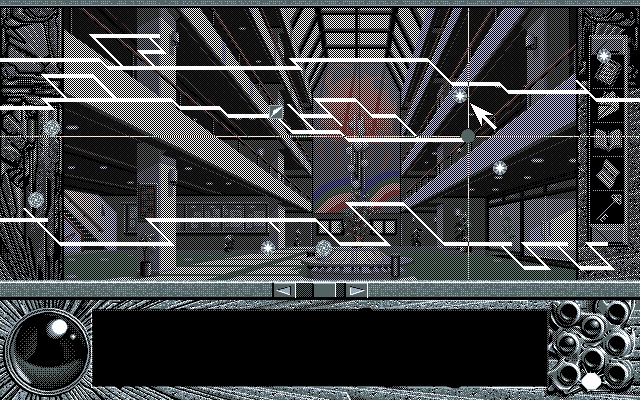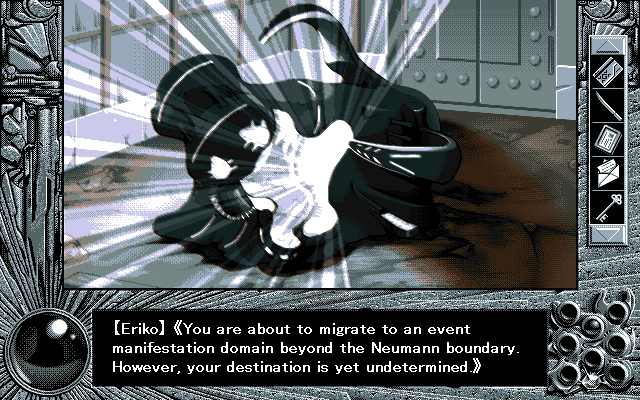Auto Diverge Mapping System
More than any other single feature, the ADMS and corresponding time travel or universe-hopping mechanics described with an impressive degree of thoroughness, plausibility, and coherency seem to be what fans cite as the core of YU-NO’s brilliance. But is this narrative structure really as deep as it appears?
In terms of game design, the ADMS offers a branching story, inventory system, open-ended structure, and ability to explore the setting, resulting in a feeling of greater freedom than the term “visual novel” connotes. Instead of a passive spectator watching PNGs spew text, I could inhabit Sakaimachi as I might the world of a platformer or RPG.
Exploration is not only of space but of different story routes, which the Reflector timeline diagram has us conceptualize as different paths winding in and out of each other. Combined with Umemoto’s excellent soundtrack and the dreamy artwork, a large part of the appeal of YU-NO is the adventure game elements and the “immersion” the almost overwhelming scope enables. More than the actual narrative or the minutiae of the trial-and-error gameplay, the ADMS framework is certainly the most important and lasting legacy of YU-NO.
Despite the dizzying presentation, the ADMS follows the time-honored video game collection structure (get the Heart Stars, Golden Bananas, Power Stars, Spiritual Stones, etc.). The player’s gameplay objective over these repeating three days is to recover the Reflector’s six missing jewels. Takuya begins with two. At the end of the three days, Takuya, often after some tragedy, finds himself warped back to the beginning of the cycle. The player preserves their entire inventory between each time hop. Majora’s Mask does it better.

At any time outside of dialogue, Takuya can deposit a jewel at his current position on the timeline on the ADMS diagram (seen above), a quick save the player can restore from any other point on any timeline. Returning to the quick save point returns the jewel to the Reflector interface in the lower right-hand corner of the screen. There are no true “game overs” in YU-NO. Even facing certain death, Takuya can use the Reflector to return to any jewel save or restart the timeline, which occurs after every “good ending” anyway. Each jewel can be reused an infinite number of times, but the limited number of jewels demands strategy that can only be developed from trial and error (or a walkthrough). Overcoming certain obstacles and puzzles requires jewel saves. Some are so unintuitive and random it is remarkable anyone figured out what to do—the worst is attaining the rope from Ryuuzouji’s storehouse, which Takuya always refuses to take except for at a certain arbitrary point on a timeline unconnected to the Mio route on which the rope is necessary. This is despite the rope always being there. Because each additional jewel permits an additional quick save, finding more jewels permits more freedom to explore the three days and uncover the histories and assorted melodrama affecting the people in Takuya’s life.

The time travel in YU-NO is not time travel per se but hopping between parallel universes, as explained early on in a lengthy essay written by Koudai, Ryuuzouji, and Imagawa. According to this “lore,” after timeline-hopping, it is impossible, without the use of a device like the Reflector, to ever return to the same universe one traveled from, a haunting and intriguing idea. Could one become at home in a universe so similar to the universe one came from if aware of its alienness? Or would that universe be alien at all? Takuya very occasionally wonders if he can ethically have sex with people when he is not the Takuya they think he is and they are not the people he knew in his life up to that point. Not that this stops him.